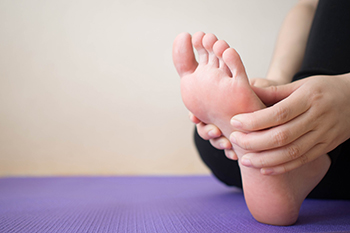Causes of and Treatment for Foot Cramps

Foot cramps can be a bothersome and painful experience, characterized by involuntary muscle contractions in the feet. These cramps can be caused by various factors, including physical activity, dehydration, ill-fitting footwear, and certain health conditions or medications. The intense tightening and sharp aching sensations can last for seconds or minutes, affecting the arches of the feet and toes. While foot cramps are usually manageable with stretching and massaging, it's essential to understand their potential causes and find effective ways to prevent them. Factors such as dehydration, electrolyte imbalances, and endocrine disorders can contribute to foot cramps. Additionally, neurological conditions, peripheral vascular disease, and even pregnancy can lead to cramping in the feet. To alleviate foot cramps, regular stretching exercises and staying hydrated are essential. Wearing well-fitting and supportive footwear, managing underlying health conditions, and massaging the affected muscles can also provide relief. If you have persistent or frequent cramping in your feet, it is suggested that you make an appointment with a chiropodist who can help with determining the underlying cause, managing them, and alleviating discomfort.
Foot pain can have many causes. To receive an accurate diagnosis and treatment for your foot pain, please consult with one of the specialists from Thornhill Foot Clinic. Our chiropodists will assess your condition and provide you with quality foot and ankle treatment.
Causes
There are a variety of different conditions that can cause foot pain, including:
Plantar fasciitis
Deformities, such as bunions or hammertoes
Injuries to the muscles, bones, tendons, or ligaments in the feet
Arthritis
Flat feet
Ingrown toenails
Symptoms
The type and location of your foot pain can help determine what may be causing it and what type of treatment options are best for you.
Common types of foot pain include:
Heel pain
Arch pain
Toe pain
Ball of foot pain
Pain that has a stabbing, burning, or tingling quality
Pain that is constant, intermittent, or that gets better or worse depending on the situation
Diagnosis
A thorough medical history and physical examination of your feet will be required to determine a diagnosis. Imaging studies, such as X-rays or MRIs may be performed to rule out or confirm certain diagnoses.
Treatment
Treatment will depend on the cause of the pain. Common treatments for foot pain include resting, icing, compressing, and elevating the affected foot, wearing orthotics, or taking anti-inflammatory medications.
If you have any questions, please feel free to contact our office located in . We offer the newest diagnostic and treatment technologies for all your foot care needs.
